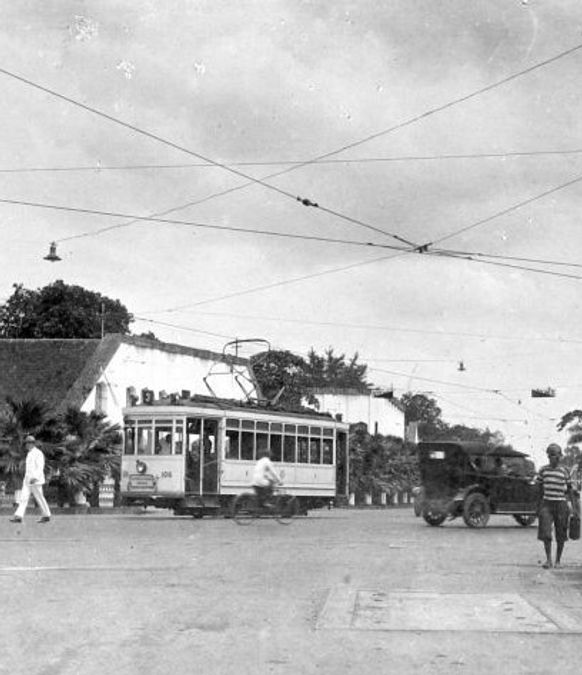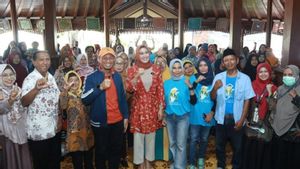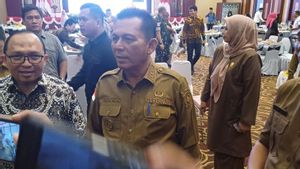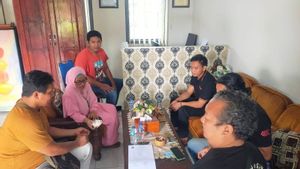JAKARTA - The development of public transportation is often known as a symbol of the progress of the times. The presence of trains and trams in the Dutch East Indies, for example. Both are the most amazing public transportation. The Dutch East Indies economy rose sharply because of it. However, the presence of trains and trams perpetuates the narrative of racism and discrimination. Carriages for the natives are placed in the lowest class: the goat class. This means that the bumiputras are equal to nothing more than livestock.
The early phase of Dutch colonialism was far from modern. The means of transportation still rely on horse power. The equestrian vehicle became the mainstay of Europeans in their daily activities. From going to work to partying.
The streets in big cities, including Batavia are still so free. No pulsation of congestion. The street view is only dominated by horse-drawn carriages passing by. That too rarely. Sado and delman are the most common two-wheeled horse-drawn carriages. Because of this, people remember that era as the age of the iron-biting horse.
It may be that horse-drawn carriages are the mainstay of transportation in short distances. But not for long distance. Long trips by horse-drawn carriage can take longer, aka days. Because horses also need rest. This weakness was recognized by the entire population from the era of the Dutch trading airline VOC, to the era of the Dutch East Indies colonial government.
The Dutch King William I in 1842 agreed with this. According to him, the Dutch East Indies needed transportation that was able to shorten the time and distance. For the sake of abundance, he thought. He tried to adopt the progress of the times by issuing the decree of the first railroad in the colony.
“Actually, it took 25 years, after the king's first railway decree for the Dutch East Indies to build the first 25 kilometers of iron rail in the colony, and it took another 10 years to build the next 300 kilometers all in Java. With heavy and slow steps, not as comfortably as Kopiist Magazine suggested, the train in the Dutch East Indies finally appeared.”
“In 1882, in the words of a special commission of the learned Indisch Genootschap: trains and 'small train tracks,' i.e. trams, also in the Dutch East Indies, proved to be the most useful of the present inventions. , the most admirable victory by man over time and distance, the most powerful incentive for hard work, the exchange of values, and civilization,” said Rudolf Mrazek in the book Engineers of Happy Land: The Development of Technology and Nationalism in a Colony (2006).
The success of the train actually sparked the establishment of other public transportation in the Dutch East Indies. One of the horse trams. The presence of trams is a solution to the limited availability of public transportation in big cities. The horse tram was then started to be built on August 10, 1867. After that, the horse tram became an effective, efficient, fast, and cheap mass transportation.
Uniquely, the materials for the construction of trams and their tracks are not only produced in the Netherlands or Java. The Dutch colonial government also involved factories in France to bring in materials. As a result, two years later the horse tram was inaugurated in Batavia on April 20, 1869. The steam tram followed soon after.
“Before there was this steam tram, there were already horse-drawn trams. This steam tram began its history in 1881. The Duemmler company, which operates the horse tram, was granted a concession to operate the steam tram with an initial capital of 1,150,000 guilders.”
"At first they used the horse tramway which was gradually replaced until it was completed in 1884. For this renovation, a new company formed under the name Nederlandsch-Indische Tramweg Maatshappij (NITM) had to get a loan of 150 thousand guilders from several companies in Amsterdam, ” written in the book Ketoprak Betawi (2001).
Racism on public transport
The progress of public transportation in Batavia was in fact not accompanied by progress in thinking. Dutch people often think they are special citizens. They always put their race as first-class citizens. While those outside the Europeans, are considered second-class citizens. And worst of all, the bumiputras are often placed in the lowest strata.
The forms of discrimination and racism appear in the class division system, whether on the train or tram. Class division is done with different rates. First class is reserved for passengers who are dominated by Europeans.
Second class is dominated by passengers who come from foreign easterners, such as Chinese, Arabs and Indians. Finally, the third class is for the natives. Usually this third class is widely known as the "goat class." This means that the bumiputras are equal to nothing more than livestock.
"In fact, according to the railway regulations set by Staatspoor-Wegen as the state railway company, train passengers are divided according to their high and low social status, economic ability, and skin color as a marker of ethnicity."
“For the first class carriages are only specifically intended for elite white European citizens; for the second class carriage intended for low-income Indos, Chinese and Arab Foreign Easters, and upper class natives; Meanwhile, the third class carriage is for indigenous commoners (kleine man) called the goat class (which equates commoners with goats)," explained Bedjo Riyanto in the book Strategy for Packing Enjoyments (2019).
The situation is clearly unfair. In fact, it is the common people who become the most passengers of trains and trams. The class tempest caused a very deep pain for the bumiputras. The white gentlemen also directly humiliated the Bumiputras, especially because the Bumiputras were often narrated as stupid and lazy humans.
That ridicule made many national figures burn with anger. Tjipto Mangoenkoesoemo became the most prominent. He often expressed his protest to the Dutch. he doubted the Dutch discriminatory treatment of the natives when they boarded the train. The figure who was often called Om Tjip by Soekarno then tried to insult the Dutch by buying a first class ticket to a beggar. As a result, Europeans feel contemptible human.
“At one point Tjipto accidentally came to a station before the arrival of the fast train specifically for white people. As soon as the train entered the station, Tjipto immediately bought a ticket and the train ticket was given to a beggar with his tattered clothes.”
"He ordered the beggar to get on the train quickly. It's just a mess of noni-noni and sinyo-sinyo and white people on the train shouting cursing and creating a commotion. That is Cipto's courage, which contains elements of eccentricity and humor, in his protest against the arrogance of the invaders,” concluded Soegeng Reksodihardjo in the book DR. Cipto Mangunkusumo (1992).
Also Read:
The English, Chinese, Japanese, Arabic, and French versions are automatically generated by the AI. So there may still be inaccuracies in translating, please always see Indonesian as our main language. (system supported by DigitalSiber.id)











